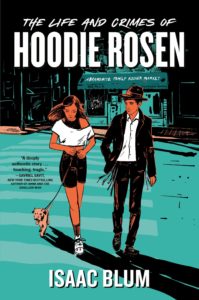
He’s an author — not an architect — but Isaac Blum is concerned with windows and mirrors nonetheless.
In his debut novel, “The Life and Crimes of Hoodie Rosen,” published by Philomel Books on Sept. 13, Blum must strike the balance between sharing a story rich with Jewish themes and culture with a broader young adult audience.
“You want your book to be a mirror to Jewish people, reflecting their experience and speaking to them that way,” Blum said. “And you also want it to be accessible enough that it opens a window into that world for non-Jewish readers.”
Blum, 33 and a Bala Cynwyd native and resident, has straddled lines of Jewish and secular most of his life. It’s a crux in his coming-of-age, which he prudently wove into the plot of “Hoodie Rosen,” his fictional Jewish bildungsroman.
The teenage Yehuda “Hoodie” Rosen must navigate a recent move his family and his Orthodox community made to the small, near-Jewless town of Tregaron, where he is distracted from his yeshiva studies by a young gentile woman, who, in addition to living a culturally drastically different life than Hoodie’s, is also the daughter of the town’s mayor who opposes the large migration of Orthodox Jews to her town. As the romance between Hoodie and his star-crossed crust escalates, so, too, does the antisemitism the bigoted townsfolk incur against the Jewish residents.
“The Life and Crimes of Hoodie Rosen” was inspired by the increase of violent antisemitism from 2016 to 2019, which culminated in the deadly shooting at a Jersey City, New Jersey, kosher grocery store.
The attack filled Blum with a sense of urgency. The shooting also occurred in tandem with a dispute in the Hudson Valley, New York, where a largely non-Jewish community opposed the development of a high rise that would house an Orthodox community. Blum paid special attention to how large communities of Jews became targets of antisemitism.
“When you have a group that, for different reasons has to move together because of their religious rituals — the way they have to walk to synagogue on the Sabbath since they can’t be in driving distance, all those sorts of things — I think it creates more natural tension that can lead to violence more easily,” Blum said.
Current events gave Blum’s novel a clear direction, but so did Blum’s own life. His mother was a Conservative Jew (Blum believes that she was the first woman to be a member of Adath Israel without her husband), and his father was an atheist.
Looking back on his upbringing in Bala Cynwyd, Blum recognized the divide in the Jewish culture there: While many Jewish community members regularly attended synagogue and Jewish day schools, others were secular or culturally Jewish.

“There is this disconnect between them, but I think there’s always been this natural line between so-called ‘Torah Jews’ and ‘not Torah Jews’,” Blum said. “One of the reasons I wanted to write the book … [was to find] where that line is, and does that line need to exist?”
Blum’s life circumstances allowed him to see either side of the line. An English major who later went on to receive his master’s of fine arts in creative writing from Rutgers University-Camden, Blum read Chaim Potok, expanding his Jewish education. To balance his writing projects with the need to find a job after school, Blum taught at Orthodox schools, where the schedule gave him the flexibility to write.
In the novel, Hoodie is infused with much of Blum’s personality: his dry, witty sense of humor; his inability to take things seriously. Certainly, Blum’s own experience with his Jewish identity and experiences working with Orthodox teens informed the book heavily.
But Blum was careful not to copy his experiences or create too many parallels between his life and Hoodie’s. He wanted to avoid the “sacred responsibility” an author may have to recreate all the details of real life and of history.
At the same time, Blum is happy to shoulder some of the responsibility of representing Judaism in literature. “Hoodie Rosen” feels personal to Blum, but he also felt it was important to depict Orthodox Jewry — though not the type of Jewry with which he identifies — as something to celebrate and find community in, not run away from.
“I am proud of having a book — I mean it’s a book with a kid with tzitzit walking down the street,” Blum said. “And there’s very, very few representations of Orthodox Judaism in young adult literature.”
Blum is writing another Jewish coming-of-age novel to be published in spring 2024.



